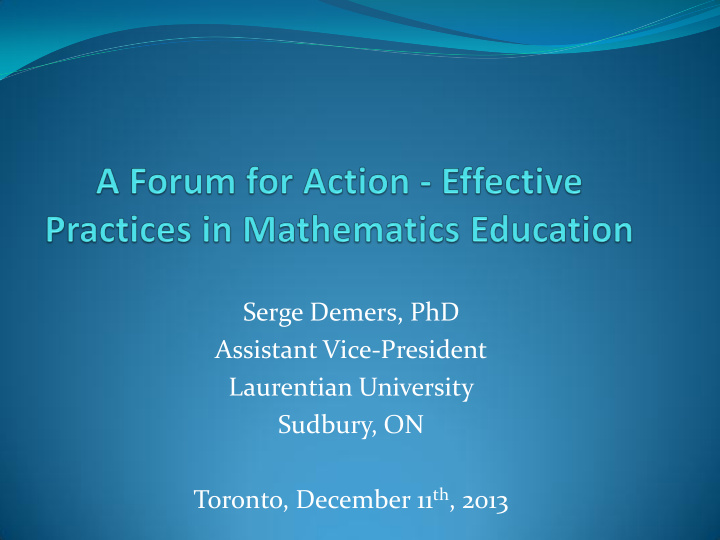



Serge Demers, PhD Assistant Vice-President Laurentian University Sudbury, ON Toronto, December 11 th , 2013
Overview Context Underlying Questions Communication Abstraction Performance issues Conclusions
Context EQAO results for Francophone students are better than Anglophone students for Grade 3 and Grade 6, and has been this way for years Results for Francophone students have a huge dip between Grade 6 and Grade 9 There are 12 Francophone school boards in the province. The EQAO scores are based on roughly: 6500 to 7500 Grade 3 students 6300 to 6500 Grade 6 students 1450 to 1525 Grade 9 Applied students 3900 to 4100 Grade 9 Academic students collège et à l’université sont très différents Une très grande variété à l’université radicalement différent d’une université à l’autre, uniforme entre les institutions qui l’offrent
EQAO Results – for context
EQAO Results – for context
EQAO Results – for context
EQAO Results – for context
The studies I have been involved in Over the years, a variety of studies and contexts Ranging from JK to Grade 12 Spanning the province Most of the studies were conducted WITHIN classrooms
The underlying questions How do students from all levels communicate in Mathematics, how to quantify it, and how to develop capacity How do students at the intermediate level manage to develop abstract thought, and move from concrete to abstract back to concrete in mathematical contexts What are factors that would explain the differential performance of Francophone students on the Grade 9 test
Communication All students, no matter their grade level or ability, are able to communicate mathematically Communication is not just talking, but also listening to another’s arguments, distilling them, and reacting if they conflict with our own Students in fairly homogeneous groups of 3 managed to generate rich discourse when the problem they faced was challenging. With Radford, produced the book Communication et apprentissage. Repères conceptuels et pratiques pour la salle de classe de mathématiques .
Abstraction Based on our study of communication, we targetted intermediate level students We built a conceptual model of how students move from concrete to abstract, and then through problem solving in small groups, were able to see this in action in students We did see that abstraction is not solidly gained in these students, and that they can easily fall back to the concrete representation With Radford, produced the book Processus d’abstraction mathématique
Performance issue In the last years, have worked with a number of boards on a collaborative inquiry model, mostly at the intermediate level The inquiry model is found to be highly engaging and effective in moving teachers’ approaches from traditional to student focused As teachers have few opportunities to share – given the size of the school – these initiatives permitted true professional learning communities Even if a lot of effort has gone into this age group, there is still a large gap in performance between Grade 6 and Grade 9
Conclusions from 10 years Students have the most success when they worked on problems as a group rather than individually. Meaningful discussions by students are critical Discussions need to occur both between the teacher and students, but more importantly space and time is given for students to discuss between themselves. Teachers need to give students open-ended questions, or questions that can be solved in a number of different ways. The use of manipulatives helps students bridge the concrete-abstract divide
Conclusions from 10 years The use of technology (read 21 st century tools) was shown in our various studies as being a very helpful tool to visualize mathematical concepts. An environment where the teacher lets students discover concepts, but also know when to intervene and teach the concept is key to good development of mathematics But most critical of all.... Teachers must strike a balance with all of the above parameters Discovery vs teaching Technology vs no technology Manipulatives when most appropriate
Recommend
More recommend